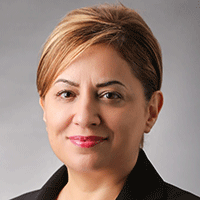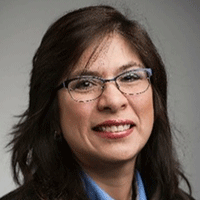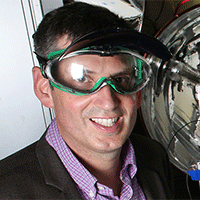Monday, July 10 | 8:00AM - 9:00AM

Nesrin Ozalp, Ph.D., ASME Fellow
Professor
Purdue University Northwest
Yellott Award Plenary Title: Solar Reactor-Based Utility-Scale Power Generation System Using Hydrogen and Carbon Fuel Cells
Abstract: Solar thermal cracking of methane coupled with hydrogen production and HFC eliminates the need for thermal energy storage required by competing thermal cracking technologies. With the combined use of HFC and CFC, solar cracking of natural gas has the potential to offer a promising alternative to present power generation cycles. Solar cracking of methane to generate electricity via both HFC and CFC has a much higher well-to-wheel efficiency compared with solar reforming or solar thermochemical cycles to produce syngas, followed by conventional internal combustion engines. Hydrogen is used in a HFC to generate electricity for the grid and the carbon is easily segregated for use in a continuously operating CFC with excess carbon used for energy storage during low demand. As the only gas released from this FC, practically pure CO2 discharged from the CFC can be readily captured for storage or used as a feedstock for syngas production via dry reforming of natural gas. Because carbon constitutes 75% by mass of the natural gas cracking product stream, the natural gas cracking process powered by the CFC has the potential to maintain full production during long term unavailability of solar energy. Such a system offers an alternative to the current state of the art of thermal storage and would change the perception of solar energy. The proposed system also offers options for continuous or intermittent operation as economics dictate. The combined solar reactor with fuel cells has the flexibility of working strictly as an electricity production unit by keeping both fuel cells explicitly for power generation and excluding the reactor when sufficient carbon and hydrogen are produced. An efficiency analysis of this hybrid system yields an optimal efficiency of 68% via perfect natural gas decomposition when accounting for compressor losses and lower heating value of natural gas. The preliminary calculations also reveal that the degree of conversion in the solar reactor significantly influences the overall system performance. Most of the CSP plants implement the Rankine cycle to convert heat to electricity with typical efficiencies of 35-40%. However, higher efficiencies may be reached via solar cracking of the natural gas coupled with HFC and CFC for a combined efficiency of 60-70%. This presentation discusses the technical details and advantages of this proposed innovative system, and its potential applications in distributed power generation and replacement of existing low-efficiency peaker plants.
Biography: Dr. Nesrin Ozalp is a Professor of Mechanical Engineering at Purdue University Northwest and a Full Professor by Courtesy at the School of Mechanical Engineering of Purdue University West Lafayette. Dr. Ozalp specializes in the areas of experimental and numerical study of thermal transport processes. Her research focuses on multiphase convective and radiative heat transfer analysis of solar thermochemical processes with non-linear temperature patterns and turbulent flow dynamics. She is the Lead Principal Investigator of research projects totaling $5M+, the corresponding author of 130+ peer reviewed publications, and Co-PI of completed Phase I of Solar Carbon Black commercialization with Fraunhofer. She is the past chair of ASME Solar Energy Executive Committee, chair of the ASME Heat Transfer and Thermal Sciences Education technical committee, Inaugural Executive Committee member of the American Society of Thermal Fluids Engineers, General Chair and/or Technical Program Chair of several ASME and ASTFE conferences, and the recipient of many research, teaching, and service awards. Dr. Ozalp is an ASME Fellow and an ASTFE Fellow.
Tuesday, July 11 | 8:00AM - 9:00AM

Judith C. Vidal, Ph.D.
Distinguished Member of Research Staff
Manager of Building Energy Science Group
Leader of Buildings Emerging Technologies Program
Buildings Technologies and Science Center
National Renewable Energy Laboratory (NREL)
Keynote Title: Energy Storage for Sustainable Buildings
Abstract: Alongside expansion in intermittent renewable power generation, electrification of building end uses like heating, water-heating, and cooking can transition residential and commercial buildings to net-zero CO2 emissions. Widespread electrification, however, has the potential to increase annual heating electricity use by over 250% and will also be a major driver of peak period electricity demand growth, particularly in colder regions. Cost-effectively decarbonizing the electricity and building sectors in parallel will require the ability to shift electricity demand to match variable and intermittent renewable generation as well as to satisfy distribution constraints. Behind-the-meter storage (BTMS) in buildings for both thermal energy storage (TES) and battery or electrical energy store (EES) can significantly increase a building’s ability to manage and shift electricity demand and is a key enabler of a net-zero CO2 energy system in the United States. NREL and other National Laboratory partners such as LBNL and ORNL are co-leading an energy storage consortium for buildings—Stor4Build—that will focus on developing and advancing integrated/packaged and stand-alone/modular energy storage systems that will accelerate the growth, optimization, deployment, and adoption of simplified and novel technologies that can be easily adopted by all Americans. Stor4Build’s 5-year outcome is a community-scale demonstration of technologies to showcase the initial achievements of the consortium, which will serve to lay a foundation for large-scale deployments of TES along with EES and systems capable of satisfying both the heating and cooling needs in buildings and thus validate the transition toward needed market transformation.
Biography: Dr. Judith Vidal from the National Renewable Energy Laboratory (NREL) is the Manager of Building Thermal Energy Science Group, the Sub-Program Lead of Buildings Emerging Technologies, and a Distinguished Member of Research Staff. Dr. Vidal is also a joint faculty member at the Colorado School of Mines (CSM). She has established an international reputation for her cutting-edge work on thermal systems and has published many journal articles on her work in journals such as Nature Materials Degradation. Dr. Vidal has received prestigious awards such as the NREL Distinguished Member of Research Staff in February 2021 and the NREL Chairman's Award in 2017.
In the area of thermal systems, optimization of thermal materials, thermomechanical evaluations of wrought alloys, their weldments, and advanced manufacturing, Dr. Vidal is currently leading several R&D efforts evaluating systems to extend the lifetime thermal components. Dr. Vidal has diversified her expertise and capabilities in other technologies such as building emerging technologies, water splitting electrolysis, fuel cells, thermoelectric, and biofuels. Her collaborative efforts, domestically and internationally, cover several technologies and leverage the R&D activities for early-stage research to create efficient and interactive buildings to help decrease energy consumption.
Wednesday, July 12 | 8:00AM - 9:00AM

Peter Loutzenhiser, Ph.D., ASME Fellow
Associate Professor
Woodruff School of Mechanical Engineering at the Georgia Institute of Technology (GIT)
Plenary Title: Harnessing the Power of Sunlight in Two-step Solar Thermochemical Cycles Utilizing Redox-active Mixed Ionic-electronic Conducting Materials
Abstract: Effectively harnessing the power of sunlight is integral for driving the transition from fossil fuels to renewable energy technologies. Research endeavors focused on coupling concentrated solar thermal technologies to thermochemical processes and cycles are offering new, promising pathways towards effectively capturing and storing sunlight to accelerate the transition. Of particular interest are two-step solar thermochemical cycles based on metal oxide reduction/oxidation (redox) reactions aimed at H2O and CO2-splitting, solar thermochemical storage, and air separation. The first step of the cycles is the thermal reduction of the metal oxide to a lower valence metal oxide or a metal and O2 driven by concentrated solar irradiation. Three different oxidation pathways are used in the second step to recover the metal oxide: (1) oxidation with H2O and/or CO2 to produce H2 and/or CO, (2) oxidation with O2 at elevated temperatures to release sensible and chemical heat for electricity generation, and (3) oxidation with O2 in air to produce N2. Redox-active mixed ionic electronic conducting (MIEC) materials are promising materials that are being investigated for integration into different solar thermochemical cycles due to attractive properties, including tunability via cation selection and substitution for different operating conditions, reactions in the absence of crystal structure changes, and thermal stability over a large range of temperatures. The net result is rapid kinetics from the facile conduction of electrons and O2- ions through the sublattice at elevated temperatures, creating charge imbalances that result in O2- vacancy formations in the sublattice. The state-of-the-art in redox-active MIEC materials will be examined for the different solar thermochemical cycles along with perspectives towards the future.
Biography: Dr. Peter Loutzenhiser is an Associate Professor in the Woodruff School of Mechanical Engineering at the Georgia Institute of Technology (GIT). He joined the faculty of GIT in May 2012 and is pursuing research in the area of Solar Thermochemistry and Technology, and he has directed research in this area funded by the U.S Department of Energy and NASA. He was the recipient of the ASME Solar Energy Division's prestigious Yellott Award in 2018, and he was elected Fellow of the ASME in 2023. He also serves as an Associate Editor for Solar Energy and is on the editorial board of Materials. Dr. Loutzenhiser received his PhD in Mechanical Engineering from Iowa State University in May 2006. Research for his PhD was performed at the Swiss Federal Laboratories for Materials Testing and Research (EMPA) and focused on Building Physics. Dr. Loutzenhiser was a post-doctoral researcher at the Paul Scherrer Institute, applying his extensive solar experience to the field of Solar Thermochemistry. He continued his research at the ETH Zurich in Solar Thermochemistry where he was a Lecturer and Research Associate prior to moving to GIT.